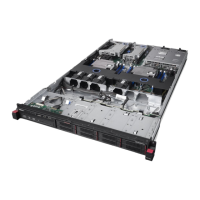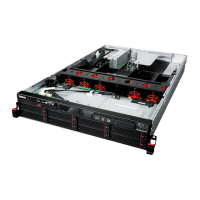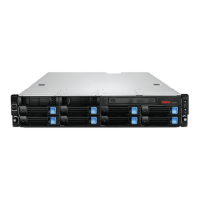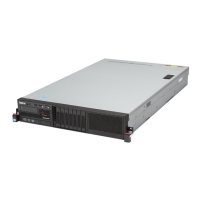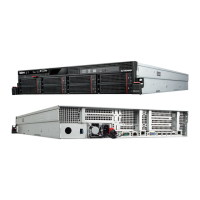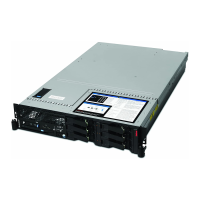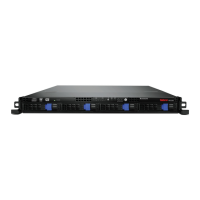











Do you have a question about the Lenovo ThinkServer RD330 and is the answer not in the manual?
Describes SAS technology, its capabilities, and its advantages in storage infrastructure.
Explains the SAS interface, its point-to-point nature, and benefits over parallel SCSI.
Details the features of the SATA bus, focusing on its high-speed, low-pin count, and low-voltage capabilities.
Discusses CacheCade software drives, their advantages like high random read speed and low latency.
Explains the MegaRAID Dimmer Switch feature, which reduces power consumption of drives by spinning them down.
Covers UEFI 2.0 support, its role in overcoming legacy BIOS limitations, and expanded platform support.
Outlines three main scenarios for using SAS RAID controllers: low-end, midrange, and high-end configurations.
Provides information on how to contact technical support for assistance with installation and configuration.
Defines RAID as an array of drives for performance and fault tolerance, appearing as a single storage unit.
Explains how RAID groups improve data reliability and fault tolerance, preventing data loss from drive failures.
Lists common RAID functions like creating hot spares, configuring drive groups, initializing drives, and rebuilding failed drives.
Introduces RAID levels as systems for ensuring availability and redundancy, and describes components like drive groups.
Lists and describes supported RAID levels from 0 to 60, including independent drives.
Discusses key factors for RAID configuration: availability, performance, and capacity.
Explains the importance of data availability without downtime and RAID's features like spare drives and rebuilds.
Covers factors for planning configurations, including controller support, drive group purpose, and spare drive availability.
Discusses how the number of drives in a group determines supported RAID levels and the need for one RAID level per virtual drive.
Introduces the SafeStore Disk Encryption service for encrypting data and managing keys for data security.
Highlights the importance of security and the benefits of SafeStore, including reduced user error and risk of data loss.
Defines key terms related to the SafeStore encryption feature, such as Authenticated Mode, Blob, and Key backup.
Details the workflow for enabling security, creating secure virtual drives, and managing security settings.
Explains the Instant Secure Erase feature for quickly erasing data from encrypted drives without additional cost.
Describes the WebBIOS CU, its operation independent of the OS, and tasks it can perform.
Provides step-by-step instructions on how to start the WebBIOS CU and access its main screen.
Details the options available on the main WebBIOS CU screen, including views, toolbars, and hotkeys.
Explains the software license key feature (Activation Key) for enabling advanced options in WebBIOS.
Guides the user through creating storage configurations using the WebBIOS CU Configuration Wizard.
Explains how to create CacheCade RAID virtual drives for the CacheCade advanced software feature.
Details how to enable, change, or disable drive security settings and import foreign configurations.
Explains how to view and change properties for controllers, virtual drives, drives, and BBUs using WebBIOS CU.
Details how to increase the size of a virtual drive by using free capacity or adding drives.
Introduces MegaRAID Recovery (Snapshot) for data recovery and automatic protection of boot volumes.
Explains how to view event messages generated by the SAS controller firmware for storage configurations and devices.
Covers maintaining and managing storage configurations, including consistency checks and deleting virtual drives.
Explains how to change power-save settings using the Dimmer Switch feature for power conservation.
Introduces MegaCLI Configuration Utility as a command-line interface for managing MegaRAID SAS RAID controllers.
Details MegaCLI Configuration Utility support for various operating systems like NetWare, SCO, Solaris, FreeBSD, and DOS.
Explains abbreviations and conventions used in MegaCLI commands, including options for controllers and virtual drives.
Introduces the Pre-boot MegaCLI (PCLI) utility, an alternative CLI access method available during system bootup.
Covers commands for creating and deleting CacheCade - SSD Caching drives to improve application performance.
Lists commands for obtaining software license keys to enable advanced features in the controller.
Details commands for managing SafeStore Security, including encrypting data and using disk-based key management.
Covers commands to set or display controller properties like virtual drive parameters and factory defaults.
Details settings for Patrol Read, a process that scans drives for errors to protect data integrity.
Covers commands for selecting settings related to the BIOS.
Explains commands for selecting settings related to the Battery Backup Unit (BBU).
Covers settings for displaying event logs and BBU terminal logs kept at the firmware level.
Details options for creating RAID drive groups from unconfigured drives and adding various RAID level configurations.
Covers selecting settings for virtual drives and performing actions like deleting or displaying information.
Covers selecting settings for drives and performing actions like displaying information or changing drive states.
Covers commands for managing enclosures, including displaying enclosure information and status.
Describes the functionality of the flash application for updating firmware.
Explains commands used to display SAS topology and PHY connection information.
Covers commands used to run diagnostic tests, including starting controller diagnostics and battery tests.
Details actions for the Recovery advanced software, including creating and managing snapshots and views.
Explains the FastPath option, an IO accelerator for CacheCade software to boost storage subsystem bandwidth.
Provides command information about the Dimmer Switch option for managing power-save settings.
Covers commands for displaying various information, including MegaCLI version and help.
Provides an overview of MegaRAID Storage Manager (MSM) software and its installation on supported operating systems.
Explains how to create storage configurations using the Configuration Wizard, including simple and advanced options.
Details how MSM displays the status of controllers, virtual drives, and drives, with error recording.
Covers system maintenance tasks like patrol read, firmware updates, and consistency checks using MSM.
Lists the hardware and software requirements for installing MegaRAID Storage Manager software.
Outlines prerequisites for MSM remote administration, including IP configuration, firewall settings, and multicasting.
Explains how to install MegaRAID Storage Manager software on Windows, Linux, and Solaris systems.
Documents MSM installation and support for VMWare Classic and VMWare ESX 3i operating systems.
Describes installing and configuring the MegaRAID CIM provider for exchanging management information across systems.
Explains installing and configuring the MegaRAID SNMP agent on Linux, Solaris, and Windows for monitoring and managing devices.
Documents MSM installation and support for Solaris 10 operating systems.
Outlines prerequisites for MSM remote administration, including IP configuration, firewall settings, and multicasting.
Explains how to start MegaRAID Storage Manager software and view its main window on different operating systems.
Describes the MegaRAID Storage Manager main menu, including panels and menu options like Dashboard, Physical, and Logical views.
Explains how to use MegaRAID Storage Manager to create and modify storage configurations on SAS controllers.
Details how to convert JBOD drives to Unconfigured Good using Create Virtual Drive or Make Unconfigured Good.
Explains how to add dedicated or global hot spare drives to replace failed drives automatically in RAID configurations.
Guides on changing adjustable rates for rebuilds and other background system tasks to optimize performance.
Explains how to use the Dimmer Switch technology to conserve energy by placing unused drives into Power-Save mode.
Describes how to change virtual drive properties like Read Policy, Write Policy, and other settings after creation.
Explains how to change virtual drive configurations by adding/removing drives or changing RAID levels using the Modify Drive Group Wizard.
Guides on deleting virtual drives to rearrange storage space, with cautions about data backup.
Explains how MegaRAID Storage Manager monitors controllers and storage devices, displaying event messages and severity levels.
Details how to control and configure alerts sent by MegaRAID Storage Manager for various system events.
Explains how to view the status of all controllers and their properties, including alarms and BBU installation.
Details how to view the status and properties of all drives, including locating drives using LEDs.
Describes how to set patrol read properties and start the operation to periodically verify drive health.
Explains how to view the status of virtual drives, including their RAID level, stripe size, and access policy.
Covers viewing the status of enclosures connected to the server, noting normal operation and failure indicators.
Explains how to monitor the status of BBUs connected to controllers, including properties like charge and temperature.
Guides on monitoring the progress of rebuilds and other lengthy operations like initialization and consistency checks.
Explains how to initialize a virtual drive after configuration, covering fast and full initialization options.
Details how to run consistency checks on fault-tolerant virtual drives to verify data redundancy and correct errors.
Covers using the Scan for Foreign Configuration option to find and import existing RAID configurations on replacement drives.
Explains how to rebuild a drive after failure, including using hot spares or replacing a failed drive.
Guides on removing a drive from a configuration and changing its state to Unconfigured Good.
Explains how to upgrade controller firmware to avoid data loss from dirty cache, forcing virtual disks to Write Through mode.
Introduces advanced software features supported by MSM and WebBIOS on MegaRAID SAS controllers for improved performance.
Lists advanced software features including FastPath, Recovery, CacheCade, and RAID 5/6.
Explains MegaRAID CacheCade for improving application performance by expanding read-caching capacity.
Describes MegaRAID FastPath, an IO accelerator for CacheCade software, boosting storage subsystem bandwidth.
Details SafeStore Encryption Services for encrypting data and providing security using key management.
Lists error levels and their meanings, indicating the severity of events in the event log.
Lists MegaRAID Storage Manager event messages with placeholders for specific values determined during event generation.
Lists MegaCLI error messages and provides descriptions for each, indicating the severity of the event.
Defines access policy as a virtual drive property indicating allowed access types: Read/Write, Read Only, or Blocked.
Defines alarm enabled as a controller property indicating if the onboard alarm is active for error conditions.
Defines alarm present as a controller property indicating if an onboard alarm is present.
Defines array as a synonym for drive group, a collection of drives attached to a RAID controller.
Defines BBU present as a controller property indicating the presence of an onboard battery backup unit.
Defines BGI rate as a controller property for background initialization rate of virtual drives.
Defines BIOS as Basic Input/Output System, stored on a flash memory chip, controlling device communication.
Defines cache as fast memory holding recently accessed data to speed up subsequent access.
Defines cache flush interval as a controller property indicating how often the data cache is flushed.
Defines caching as using high-speed memory to speed up read/write performance.
Defines capacity as a property indicating the amount of storage space on a drive or virtual drive.
Defines coerced capacity as a drive property indicating capacity forced for compatibility with other drives.
Defines coercion mode as a controller property for forcing drives of varying capacities to a common size.
Defines consistency check as an operation verifying stripe consistency and fixing errors in redundant RAID levels.
Defines consistency check rate as the rate at which consistency check operations are run.
Defines controller as a chip managing data transfer between microprocessor, memory, and peripherals.
Defines copyback as copying data from a source drive to a destination drive, often for configuration restoration.
Defines current write policy as a virtual drive property indicating support for Write Back or Write Through mode.
Defines default write policy as a virtual drive property indicating the default Write Through or Write Back policy.
Defines device ID as a controller or drive property indicating the manufacturer-assigned device ID.
Defines device port count as a controller property indicating the number of host data ports.
Defines drive cache policy as a virtual drive property indicating if the virtual drive cache is enabled, disabled, or unchanged.
Defines drive group as a set of drives attached to a RAID controller for creating virtual drives.
Defines drive state as a property indicating the drive's status (e.g., Online, Unconfigured Good, Failed).
Defines drive type as a drive property indicating the drive's characteristics.
Defines EKM as External Key Management.
Defines fast initialization as a mode that quickly writes zeroes to virtual drive sectors, allowing immediate data writing.
Defines fault tolerance as the capability to withstand single drive failures without compromising data integrity.
Defines firmware as software stored in ROM, responsible for system behavior on startup.
Defines foreign configuration as an existing RAID configuration on replacement drives that can be imported or cleared.
Defines formatting as writing a specific value to data fields to map out unreadable or bad sectors.
Defines hole in MegaRAID Storage Manager as a block of empty space in a drive group for defining a virtual drive.
Defines host interface as a controller property indicating the computer host system's interface type (e.g., PCIX).
Defines host port count as a controller property indicating the number of host data ports.
Defines host system as any computer system where the controller is installed.
Defines hot spare as a standby drive that automatically replaces failed drives in a virtual drive, preventing data loss.
Defines initialization as writing zeros to virtual drive data fields and generating parity for a Ready state.
Defines IO policy as a virtual drive property indicating Cached I/O or Direct I/O mode.
Defines learning cycle as a battery calibration operation performed periodically to determine battery condition.
Defines load-balancing as spreading work across resources to maximize use, throughput, or response time.
Defines LKM as Local Key Management.
Defines media error count as a drive property indicating detected errors on the drive media.
Defines migration as moving virtual drives and hot spares between controllers.
Defines mirroring as providing data redundancy by maintaining an exact copy of data on a second drive.
Defines multipathing as support for detecting and using multiple paths to SAS devices for increased reliability.
Defines name as a virtual drive property indicating the user-assigned name.
Defines non-redundant configuration as a RAID 0 virtual drive without mirroring or parity, offering high throughput but no protection.
Defines NVRAM as non-volatile random access memory used to store firmware and configuration data.
Defines NVRAM present as a controller property indicating if NVRAM is present.
Defines NVRAM size as a controller property indicating NVRAM capacity.
Defines offline as a drive state where data is not accessible to the virtual drive.
Defines patrol read as a process checking drives for errors to prevent failure and protect data integrity.
Defines patrol read rate as the user-defined rate at which patrol read operations are run.
Defines product info as a drive property indicating the vendor-assigned model number.
Defines product name as a controller property indicating the manufacturing name.
Defines RAID as a group of independent drives for high performance and data availability.
Defines RAID 0 as using data striping for high throughput, suitable for large files without redundancy needs.
Defines RAID 00 as data striping in a spanned group for high throughput, suitable for large files without redundancy.
Defines RAID 1 as data mirroring for complete redundancy, ideal for small databases requiring fault tolerance.
Defines RAID 5 as data striping and parity for high throughput and redundancy, suitable for random access.
Defines RAID 6 as data striping and parity for high throughput and redundancy, surviving two drive failures.
Defines RAID 10 as data striping across mirrored groups for high throughput and complete redundancy.
Defines RAID 50 as data striping across drive groups with parity data for high reliability and throughput.
Defines RAID 60 as data striping across drive groups with parity data, surviving two drive failures per set for high protection.
Defines RAID level as a virtual drive property indicating the RAID level, with SAS controllers supporting levels 0-60.
Defines raw capacity as the drive's actual full capacity before coercion.
Lists trademarks of Lenovo, Microsoft, and Intel, and notes that other names may be trademarks of others.
| Bus type | QPI |
|---|---|
| Stepping | M1 |
| FSB Parity | No |
| Scalability | 2S |
| Processor code | SR0LR |
| Processor cache | 10 MB |
| Processor cores | 4 |
| Processor model | E5-2407 |
| System bus rate | 6.4 GT/s |
| Processor series | Intel Xeon E5-2400 |
| Processor socket | LGA 1356 (Socket B2) |
| Processor codename | Sandy Bridge EN |
| Motherboard chipset | Intel® C606 |
| Processor frequency | 2.2 GHz |
| Processor cache type | Smart Cache |
| Processor lithography | 32 nm |
| Processor manufacturer | Intel |
| Processor package size | 45 x 42.5 mm |
| Processor front side bus | - MHz |
| Processor operating modes | 64-bit |
| ECC supported by processor | Yes |
| Supported instruction sets | AVX |
| Thermal Design Power (TDP) | 80 W |
| Number of processors installed | 1 |
| Maximum number of SMP processors | 2 |
| Maximum number of PCI Express lanes | 24 |
| Memory types supported by processor | DDR3-SDRAM |
| Memory channels supported by processor | Triple |
| Memory clock speeds supported by processor | 800, 1066 MHz |
| Memory bandwidth supported by processor (max) | 25 GB/s |
| Maximum internal memory supported by processor | 375 GB |
| HDD size | 3.5 \ |
| HDD interface | Serial ATA, Serial Attached SCSI (SAS) |
| Optical drive type | DVD-RW |
| Total storage capacity | 0 GB |
| Maximum storage capacity | 12 TB |
| Number of HDDs installed | 0 |
| Memory slots | 12 |
| Internal memory | 4 GB |
| Memory clock speed | 1333 MHz |
| Maximum internal memory | 192 GB |
| Cabling technology | 10/100/1000Base-T(X) |
| Ethernet interface type | Gigabit Ethernet |
| PS/2 ports quantity | - |
| USB 2.0 ports quantity | 6 |
| Ethernet LAN (RJ-45) ports | 3 |
| Compatible operating systems | Windows Server 2012\\r Windows Server 2008\\r Windows Server 2008 R2\\r Windows Small Business Server 2011\\r Novel SUSE Linux Enterprise Server\\r VMware vSphere and VMware ESXi |
| Chassis type | Rack (1U) |
| Power supply | 550 W |
| Sustainability certificates | ENERGY STAR |
| PCI Express slots version | 3.0 |
| Processor ARK ID | 64614 |
| Intel Identity Protection Technology version | 0.00 |
| Depth | 734 mm |
|---|---|
| Width | 482.4 mm |
| Height | 43.6 mm |
| Weight | 17000 g |
